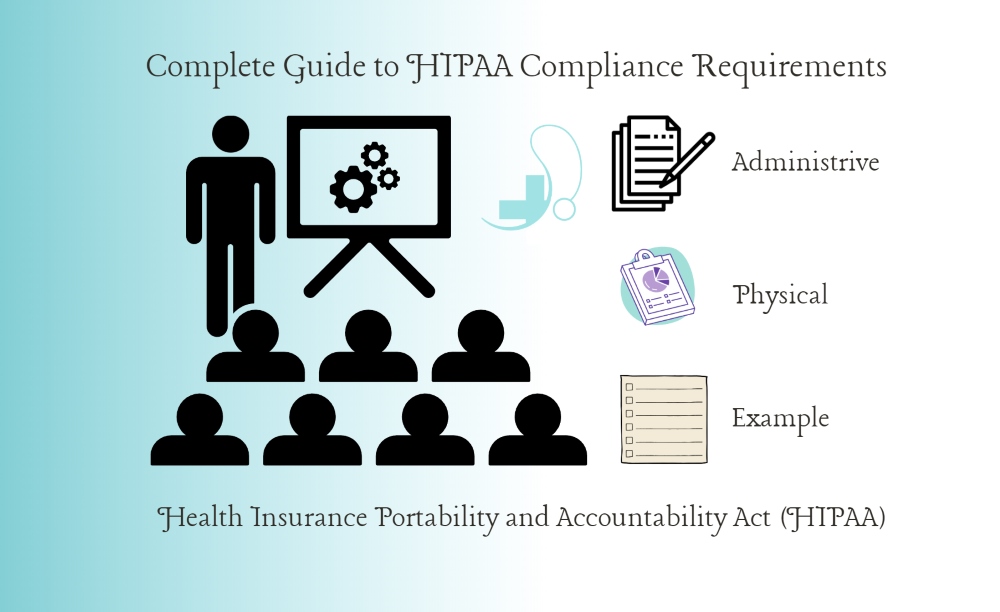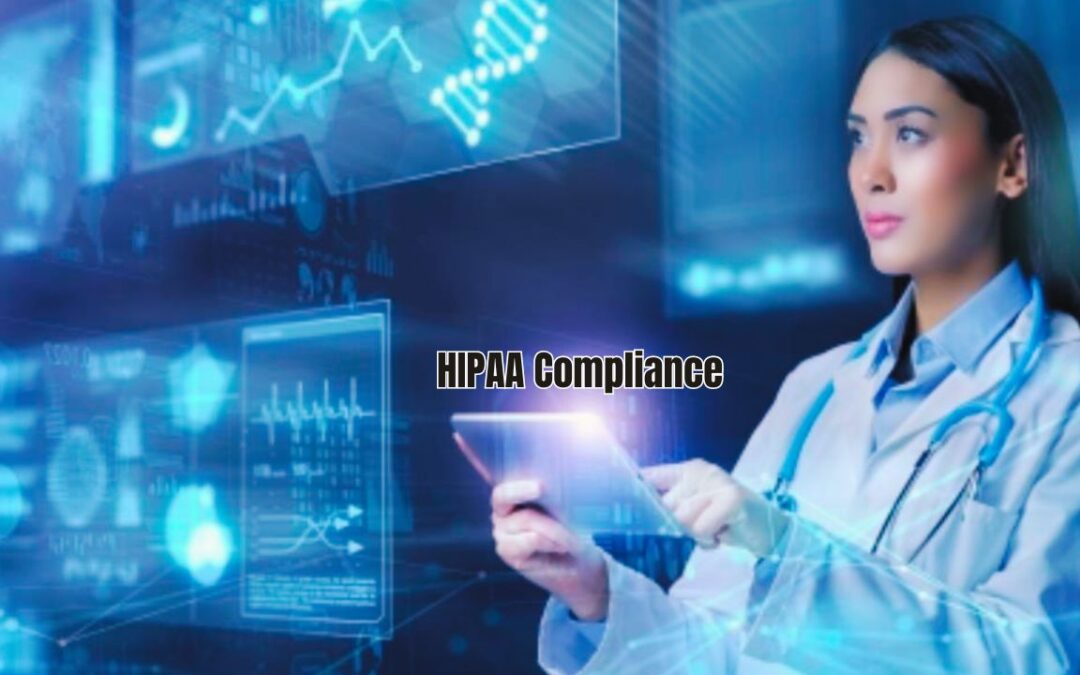Table of Contents
If you’re confused by HIPAA compliance requirements? Our blog explains what you MUST do to protect patient privacy & stay compliant. The Health Insurance Portability and Accountability Act (HIPAA) was passed in 1996 to create national standards for the safety and security of sensitive patient information. The act purpose is to save Protected Health Information (PHI) while ensuring that individuals have access to their health information and that healthcare data flows smoothly to offer high-quality care.
Compliance with HIPAA is required for all covered entities, including healthcare providers, health plans, and healthcare clearinghouses, as well as their business affiliates who handle PHI. This article delves into the essential HIPAA compliance standards and offers actionable ideas for firms seeking to protect sensitive health information effectively.
Understanding HIPAA Compliance
HIPAA is a federal law that prevents sensitive patient health information from being disclosed without the patient’s consent or knowledge. The legislation contains various rules, including the Privacy, Security Rule, Breach Notification Rule, and Enforcement Rule, which cover distinct areas of preserving and securing PHI.
HIPAA compliance is crucial for maintaining the privacy and security of PHI. Non-compliance can result in severe penalties, including hefty fines and damage to an organization’s reputation. More importantly, it ensures the trust and confidence of patients in the healthcare system, as their sensitive information is handled with the utmost care and confidentiality.
Key Requirement for HIPAA Compliance
Here are the following key HIPAA Compliance requirements.
1. Administrative Safeguards
Administrative protections are the foundation of an organization’s HIPAA compliance program. These safeguards ensure policies and procedures are in place to monitor employee behavior and protect personal health information. They focus on managing how a covered entity handles PHI, like access control and staff training. Key components include:
Security Management Process
Companies must implement a security management process to recognize and manage risks to PHI. This includes:
- Conducting regular risk assessments to identify potential threats and vulnerabilities to PHI.
- Implementing security measures to reduce risks to an acceptable level.
- Establishing and enforcing sanctions against workforce members who fail to comply with security policies and procedures.
- Regularly reviewing records of information system activity, such as audit logs, access reports, and security incident tracking.
Assigned Security Responsibility
Each organization must designate a security official responsible for developing and implementing its security policies and procedures. This individual oversees the entire HIPAA compliance program and ensures adherence to the regulations. This official superintends the overall HIPAA security program.
Workforce Training and Management
Effective workforce training and management are critical for HIPAA compliance. Organizations must:
- Educate all employees, including management, on HIPAA regulations, security policies, and procedures.
- Ensure workforce members have appropriate access to PHI for their jobs and responsibilities.
- Ensure staff follow security policies and procedures, and take corrective action as needed.
Evaluation
Organizations must regularly evaluate their security policies and procedures to ensure they continue to protect PHI effectively. This involves:
- Conducting evaluations at regular intervals or in response to environmental or operational changes that may affect the security of PHI.
- Revising policies and procedures based on evaluation findings to address new risks or vulnerabilities.
2. Physical Safeguards
Physical safeguards protect the physical access to facilities and devices that store or transmit PHI. Key components include:
Facility Access Controls
Organizations must implement policies and procedures to limit physical access to facilities while ensuring that authorized access is allowed. This includes:
- Establishing procedures to allow facility access in support of restoration of lost data under a disaster recovery plan.
- Implementing policies to safeguard the facility and the equipment therein from unauthorized physical access, tampering, and theft.
- Implementing procedures to control and validate a person’s access to facilities based on their role or function.
- Maintaining records of repairs and modifications to the physical components of a facility related to security.
Workstation Use and Security
- Workstations, including desktop computers and laptops, are common access for PHI. Organizations must ensure workstations are used in secure environments and protected from unauthorized access:
- Implementing rules and procedures that outline the required functions, how they should be performed, and the physical characteristics of a given workstation or type of workstation access to PHI.
- Implementing the physical measures on all workstations that ePHI limits access to authorized users.
Device and Media Controls
Organizations must implement policies and procedures governing the receipt and removal of hardware and electronic media that contain PHI. This includes:
- Ensuring that PHI and ePHI are disposed of securely when they are no longer needed.
- Ensuring that before electronic media are made available for reuse, ePHI is deleted from them.
- Keeping track of who is in charge of moving hardware, electronic media, and other items.
- Preparing a replica of the ePHI that may be retrieved when needed before moving the device.
3. Technical Safeguards
Technical safeguards involve the technology and policies used to protect and control access to PHI. Key components include:
Access Control
Organizations must implement technical policies and procedures to allow access to ePHI only to those persons or software programs that have been granted access rights:
- Assigning a unique name or number identifying and tracking user identity.
- Establishing procedures for obtaining necessary ePHI during an emergency.
- Implementing electronic procedures that terminate an electronic session after a predetermined time of inactivity.
- Implementing mechanisms to encrypt and decrypt ePHI as necessary.
Audit Controls
Organizations must implement mechanisms to record and examine activity in information systems that contain or use ePHI:
- Recording user activities, exceptions, and information security events.
- Regularly monitoring audit logs and access reports to identify any unauthorized access or suspicious activity. This will help to control data privacy more effectively.
Integrity Controls
Organizations must implement strict policies and procedures to ensure that ePHI is not improperly altered or destroyed:
- Mechanism to Authenticate ePHI: Implementing electronic mechanisms to confirm that ePHI has not been altered or destroyed in an unauthorized manner.
Transmission Security
Organizations must implement technical security measures to guard against unauthorized access to ePHI transmitted over an electronic network:
- Implementing security measures to ensure that electronically transmitted ePHI is not improperly modified without detection.
- Implementing encryption for ePHI when it is transmitted over electronic communication networks.
HIPAA Privacy Rule
The HIPAA Privacy Rule establishes national standards to protect individuals’ medical records and other personal health information. It applies to covered entities and their business associates. Key elements include:
Patient Rights
Patients have specific rights under the HIPAA Privacy Rule, including:
• Patients have the right to access and request copies of their health records.
• They can also request corrections if they believe their information is inaccurate or incomplete.
• Patients can obtain an accounting of PHI disclosures from covered entities.
• Patients have the right to request restrictions on the use and disclosure of their personal health information (PHI).
• They can also request alternate communication methods or places.
Disclosure Permissions
The HIPAA Privacy Rule provides guidelines on how PHI can be shared. It requires patient consent for certain disclosures and outlines permissible uses and disclosures without patient authorization, such as for treatment, payment, and healthcare operations. Covered entities must:
- Obtain patient authorizations for uses and disclosures of PHI not otherwise permitted by the Privacy Rule.
- Make reasonable efforts to ensure that necessary information is disclosed to achieve the intended purpose.
Notice of Privacy Practices
Covered entities must provide patients with a Notice of Privacy Practices (NPP) that explains their privacy rights and how their information will be used and disclosed. The NPP must:
- Ensure the notice is easy to understand.
- Clearly outline how the covered entity will use and disclose PHI.
- Inform patients of their rights regarding their PHI.
- Outline the covered entity’s legal duties to protect PHI.
HIPAA Security Rule
The HIPAA Security Rule establishes national standards to protect individuals’ electronic PHI (ePHI) created, received, used, or maintained by a covered entity. It requires appropriate administrative, physical, and technical safeguards to ensure the confidentiality, integrity, and security of ePHI. Key elements include:
Risk Analysis and Management
Organizations must conduct a thorough risk analysis to identify potential threats and vulnerabilities to ePHI and implement measures to mitigate those risks. This involves:
- Identifying and documenting potential threats and vulnerabilities to ePHI.
- Implementing security measures to reduce identified risks to a reasonable and appropriate level.
Security Measures
Organizations must implement a range of security measures to protect ePHI, including:
- Developing policies and procedures to manage the selection, development, implementation, and maintenance of security measures to protect ePHI.
- Implementing measures to protect the physical security of facilities and equipment that store ePHI.
- Utilizing technology to protect ePHI and control access to it.
Breach Notification
The HIPAA Breach Notification Rule requires covered entities and business associates to notify affected persons, the Department of Health and Human Services (HHS), and, in some situations, the media about breaches involving unsecured PHI.
Key steps include:
- Notifications must be made without unreasonable delay and no later than 60 days after detecting a breach.
- Notifications must include a description of the breach, the types of information implicated, precautions individuals should take to protect themselves, and actions taken to investigate and remediate the incident.
Ensuring HIPAA Compliance: Best Practices
Achieving and maintaining HIPAA compliance requires a proactive and continuous effort. Here are some best practices organizations should adopt:
Regular Training
Continuous education is critical for ensuring all employees understand HIPAA regulations and the importance of protecting PHI. Training programs should:
- Provide an overview of HIPAA, including the Privacy and Security Rule, and Breach Notification Rule.
- Tailor training to the specific roles and responsibilities of employees.
- Offer regular refresher courses and updates on new regulations or changes to existing policies.
Updated Policies and Procedures
Organizations should regularly review and update their policies and procedures to reflect changes in regulations and emerging threats. This includes:
- Conducting periodic reviews of security policies and procedures.
- Revising protocols based on new risks or vulnerabilities identified through risk assessments.
Comprehensive Risk Assessments
Performing routine risk assessments is vital for identifying and addressing potential vulnerabilities. This process should include:
• Identifying risks and vulnerabilities to PHI.
• Taking steps to reduce identified risks.
• Assessing the possibility and impact of identified hazards.
Incident Response Plans
Organizations must create and test incident response plans to effectively manages and mitigate data breaches. Key elements include:
• Developing tools to detect potential security incidents.
• Developing methods for responding to security incidents.
• Taking steps to contain and minimize the consequences of a breach.
• Developing methods to notify affected persons and regulatory organizations.
Wrap Up
Compliance with HIPAA is a challenging but necessary obligation for firms that handle protected health information. Understanding and executing the extensive criteria provided in this article allows enterprises to secure sensitive health information, avoid hefty penalties, and establish confidence with patients and clients.
Regular evaluations, updated policies, and ongoing training are critical to ensuring strong HIPAA compliance requirements.

Read More: What is risk adjustment in health care?

